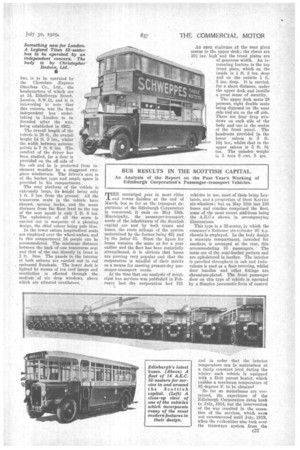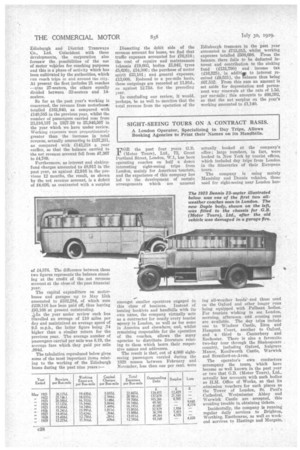BUS RESULTS IN THE SCOTTISH CAPITAL.
Page 59

Page 60

If you've noticed an error in this article please click here to report it so we can fix it.
An Analysis of the Report on the Past Year's Working of Edinburgh Corporation's Passenger-transport Vehicles.
THEmunicipal year in most cities and towns finishes at the end of March, but so far as the transport department of the Edinburgh Corporation is concerned, it ends on May 15th. Municipally, the passenger-transport needs of the inhabitants of the Scottish capital are met by both trams and buses, the route mileage of the system maintained by the former being 42i. and by the latter 51. Since the figure for buses remains the same as for a year earlier and the fleet has been materially strengthened, it is obvious that buses are proving very popular and that the corporation is mindful of their merits as a means for meeting present-day passenger-transport needs.
At the time that our analysis of municipal bus services was published in February last the corporation had 121
An open staircase at the rear givees access to the upper deck ; the risers are 101 ins, high' and the tread plates are of generous width. An interesting feature is the top tread plate, which on the inside is 1 ft. 3 ins, deep and on the outside 1 ft.. 5 ins. deep. It is carried, for a short distance, under the upper deck and instills a great sense of security.
The upper deck seats 28 persons, eight double seats being disposed on the near side and six on the off side. There are four drop windows on each side of the body and one in the centre of the front panel. The headroom provided in the lower saloon is 5 ft. 10i ins., whilst that in the upper saloon is 5 ft. 81 ins. The unladen weight -is 5 tons 6 cwt. 3 qrs.
vehicles in use, most of them being Ley lands, and a proportion of them Kerrie six-wheelers ; but on May 15th last 130 buses and coaches comprised the fleet, some of the most recent additions being the A.E.C.s. shown in accompanying illustrations.
This type is a 32-seater, in which the company's Reliance six-cylinder 95 h.p. chassis is employed. In the body design a separate compartment, intended for smokers, is arranged at the rear, this accommodating 10 passengers. ' The seats are of the semi-bucket pattern and are upholstered in leather. The interior is panelled throughout in oak and Indurole= is used as a floor covering, whilst door handles and other fittings are chromium-plated. The front passenger door on this type of vehicle is operated by a Simplex pneumatic form of control Edinburgh and District Tramways Co., Ltd. Coincident with these developments, the corporation also foresaw the possibilities of the use of motor vehicles for coaching purposes and this is a phase of activity which has been cultivated by the authorities, which run coach trips in and around the city. At present the fleet includes 21 coaches —nine 27-seaters, the others equally divided between 32-seaters and 14seaters.
So far as the past year's working is concerned, the revenue from motorbus, totalled £161,940, as compared with £149,585 in the previous year, whilst the number of passengers carried rose from 23,316,157 in 1927-28 to 25,946,507 in the year which we have under review. Working expenses were proportioiiitely greater than the increase in total revenue, actually amounting to £157,231, as compared with £142,218 a year earlier, so that the balance carried to the net revenue account fell from 17,367 to £4,709.
Furthermore, as interest and sinkingfund charges amounted to £8,913 in the past year, as against £2,916 in the previous 12 months, the result, as shown by the net revenue account, is a deficit of £4,026, as contrasted with a surplus
of £4,576. The difference between these two figures representsthe balance standing at the credit of the net revenue account at the close of the past financial year
The capital expenditure on motorbuses and garages up to May 15th amounted to £332,284, of which sum £239,116 has been paid off, thus leaving £93,168 at present outstanding.
.,In the year under review each bus travelled an average of 110 miles per day and maintained an average speed of 9.5 m.p.h., the latter figure being .74 higher than a similar return for the previous year. The average number of passengers carried per mile was 8.19, the average fare which they paid per mile .994d.
The tabulation reproduced below gives some of the most important items relating to the working of the Edinburgh buses during the past nine years :— Dissecting the debit side of the revenue account for buses, we find that traffic expenses accounted for £76,816; the cost of repairs and maintenance (chassis £19,603, bodies £5,943, tyres £5,626), £34,300; the purchase of motor spirit £33,101; and general expenses, £13,008. Reduced to a per-mile basis, these outgoings are recorded at 11.91d., as against 12.75d. for the preceding ear.
In concluding our review, it would, perhaps, be as well to mention that the total revenue from the operation of the Edinburgh tramcars in the past year amounted to £715,015, whilst working expenses totalled £508,698. From the balance there falls to be deducted interest and contribution to the sinking fund (£131,790) and income tax (£16,525), in additiap to interest received (£9,531), the alance thus being £67,532. From this sum an amount is set aside for depreciation and permanent way renewals at the rate of 1.5d. per car-mile; this amounts to £66,392, so that the net surplus on the year's working amounted to £1,140.












































































































